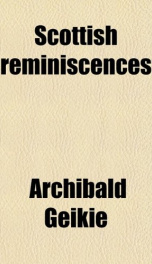scottish reminiscences

Purchase of this book includes free trial access to www.million-books.com where you can read more than a million books for free. This is an OCR edition with typos. Excerpt from book: CHAPTER III. THE sermon in Scottish Kirks. Intruding animals in country churches. The ' collection.' Church psalmody. Precentors and organs. Small congregations in the Highlands. Parish visitation. Survival of the influence of clerical teaching. Religious mania. From the time of the Reformation onwards the sermon has taken a foremost place in the service of the Church of Scotland. There was a time when a preacher would continue his discourse for five or six hours, and when sometimes a succession of preachers would give sermon after sermon and keep the congregation continuously sitting for ten hours. These days of perfervid oratory are past. But a sermon of an hour's duration or even more may still be heard, and, when the preacher is eloquent, will be listened to with deep interest. This part of the service maintains its early prominence. It is from his capacity to preach that a man's qualifications for theministry are mainly judged, not merely by the church which licences him, but by the congregation which chooses him as its pastor. The half-yearly celebration of the sacrament, which included a fast-day, services on two or three week days, and a long 'diet' on Sunday, was appropriately known as 'The Preachings.' The Fast-Day, when the shops were closed and there were at least two services in the churches, forenoon and afternoon, became in the end a kind of public holiday in the large towns. Attracted to the country, rather than to the sermons, the people used to escape from town, and railways carried an ever- increasing number of excursionists away from the services of the Church. The ecclesiastical authorities at last, some years ago, put a stop to this scandal, and the Fast-Day no longer ranks as one of the public holidays of the year. Scottish sermons have always had a...
Info about the book
Author:
Series:
Unknown
ISBN:
1171898304
Rating:
4.5/5 (2)Your rating:
0/5
Languge:
English
Users who have this book
Users who want this book
What readers are saying
What do you think? Write your own comment on this book!
write a commentGenre
if you like scottish reminiscences try:
Other books by this author
Do you want to read a book that interests you? It’s EASY!
Create an account and send a request for reading to other users on the Webpage of the book!


